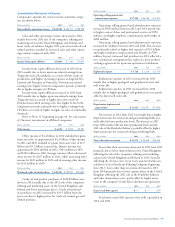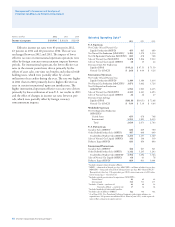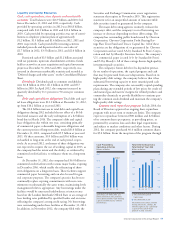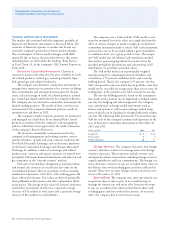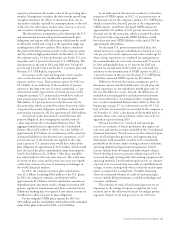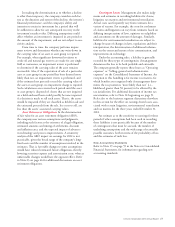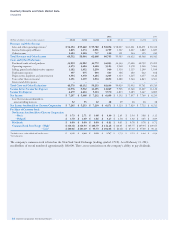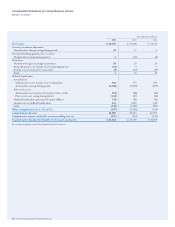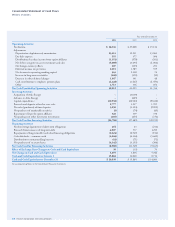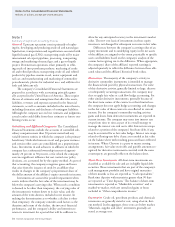Chevron 2012 Annual Report Download - page 29
Download and view the complete annual report
Please find page 29 of the 2012 Chevron annual report below. You can navigate through the pages in the report by either clicking on the pages listed below, or by using the keyword search tool below to find specific information within the annual report.Chevron Corporation 2012 Annual Report 27
In making the determination as to whether a decline
is other than temporary, the company considers such fac-
tors as the duration and extent of the decline, the investee’s
nancial performance, and the company’s ability and
intention to retain its investment for a period that will
be sucient to allow for any anticipated recovery in the
investment’s market value. Diering assumptions could
aect whether an investment is impaired in any period or
the amount of the impairment, and are not subject to sen-
sitivity analysis.
From time to time, the company performs impair-
ment reviews and determines whether any write-down in
the carrying value of an asset or asset group is required.
For example, when signicant downward revisions to
crude oil and natural gas reserves are made for any single
eld or concession, an impairment review is performed
to determine if the carrying value of the asset remains
recoverable. Also, if the expectation of sale of a particular
asset or asset group in any period has been deemed more
likely than not, an impairment review is performed, and
if the estimated net proceeds exceed the carrying value of
the asset or asset group, no impairment charge is required.
Such calculations are reviewed each period until the asset
or asset group is disposed of. Assets that are not impaired
on a held-and-used basis could possibly become impaired
if a decision is made to sell such assets. at is, the assets
would be impaired if they are classied as held-for-sale and
the estimated proceeds from the sale, less costs to sell, are
less than the assets’ associated carrying values.
Asset Retirement Obligations In the determination
of fair value for an asset retirement obligation (ARO),
the company uses various assumptions and judgments,
including such factors as the existence of a legal obligation,
estimated amounts and timing of settlements, discount
and ination rates, and the expected impact of advances
in technology and process improvements. A sensitivity
analysis of the ARO impact on earnings for 2012 is not
practicable, given the broad range of the company’s long-
lived assets and the number of assumptions involved in the
estimates. at is, favorable changes to some assumptions
would have reduced estimated future obligations, thereby
lowering accretion expense and amortization costs, whereas
unfavorable changes would have the opposite eect. Refer
to Note 23 on page 66 for additional discussions on asset
retirement obligations.
Contingent Losses Management also makes judg-
ments and estimates in recording liabilities for claims,
litigation, tax matters and environmental remediation.
Actual costs can frequently vary from estimates for a
variety of reasons. For example, the costs for settlement
of claims and litigation can vary from estimates based on
diering interpretations of laws, opinions on culpability
and assessments on the amount of damages. Similarly,
liabilities for environmental remediation are subject to
change because of changes in laws, regulations and their
interpretation, the determination of additional informa-
tion on the extent and nature of site contamination, and
improvements in technology.
Under the accounting rules, a liability is generally
recorded for these types of contingencies if management
determines the loss to be both probable and estimable.
ecompany generally reports these losses as “Operating
expenses” or “Selling, general and administrative
expenses” on the Consolidated Statement of Income. An
exception to this handling is for income tax matters, for
which benets are recognized only if management deter-
mines the tax position is“more likely than not” (i.e.,
likelihood greater than 50percent) to be allowed by the
tax jurisdiction. For additional discussion of income tax
uncertainties, refer to Note 14 beginning on page 51.
Refer also to the business segment discussions elsewhere
in this section for the eect on earnings from losses asso-
ciated with certain litigation, environmen tal remediation
and tax matters for the three years ended December 31,
2012.
An estimate as to the sensitivity to earnings for these
periods if other assumptions had been used in recording
these liabilities is not practicable because of the number
of contingencies that must be assessed, the number of
underlying assumptions and the wide range of reasonably
possible outcomes, both in terms of the probability of loss
and the estimates of such loss.
New Accounting Standards
Refer to Note 17, on page 55 in the Notes to Consolidated
Financial Statements, for information regarding new
accounting standards.


